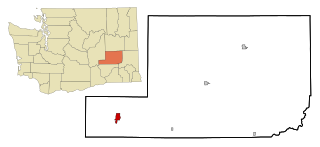
Fremont is a city in Alameda County, California, United States. Located in the East Bay region of the Bay Area, Fremont has a population of 230,504 as of 2020, making it the fourth most populous city in the Bay Area, behind San Jose, San Francisco, and Oakland. It is the closest East Bay city to the high-tech Silicon Valley network of businesses, and has a strong tech industry presence.

U.S. Route 101, or U.S. Highway 101 (US 101), is a north–south highway that traverses the states of California, Oregon, and Washington on the West Coast of the United States. It is part of the United States Numbered Highway System and runs for over 1,500 miles (2,400 km) along the Pacific Ocean. The highway is also known by various names, including El Camino Real in parts of California, the Oregon Coast Highway, and the Olympic Highway in Washington. Despite its three-digit number, normally used for spur routes, US 101 is classified as a primary route.

Gila Bend, founded in 1872, is a town in Maricopa County, Arizona, United States. The town is named for an approximately 90-degree bend in the Gila River, which is near the community's current location. As of the 2020 census, the population of the town was 1,892.

Lafayette is a city in Contra Costa County, California, United States. As of 2020, the city's population was 25,391. It was named after the Marquis de Lafayette, a French military officer of the American Revolutionary War.

Madill is a city in and the county seat of Marshall County, Oklahoma, United States. It was named in honor of George Alexander Madill, an attorney for the St. Louis-San Francisco Railway. The population was 3,914 as of the 2020 Census, up 3.8% from the figure reported in the 2010 census of 3,770, which itself was an increase of 10.8 percent from the 3,410 reported at the 2000 census. It is best known as the site of the annual National Sand Bass Festival. It is part of the Texoma region.

Bend is a city in Central Oregon and the county seat of Deschutes County, Oregon, United States. It is located to the east of the Cascade Range, on the Deschutes River.

Hatton is a small incorporated town in Adams County, Washington, United States. The population was 79 at the 2020 census.

Cypress Lawn Memorial Park, established by Hamden Holmes Noble in 1892, is a rural cemetery located in Colma, California, a place known as the "City of the Silent".

Adolph Claus J. Spreckels was a major industrialist in Hawai'i during the kingdom, republican, and territorial periods of the islands' history. He also involved himself in several California enterprises, most notably the company that bears his name, Spreckels Sugar Company.

Stephen Mallory White was an American attorney and politician from California. A Democrat, he was most notable for his service as a U.S. Senator from 1893 to 1899.
Maybert was a mining town in Nevada County, California. It was located on the south side of the South Yuba River, about 6 miles east of the town of Washington, at an elevation of 3,245 ft (989 m). Fall Creek empties into the South Yuba slightly to the northwest of the town site.

The Department of California was an administrative department of the United States Army. The Department was created in 1858, replacing the original Department of the Pacific, and it was ended by the reorganizations of the Henry L. Stimson Plan implemented in February 1913. As with the preceding organization, headquarters were in San Francisco. Its creation was authorized by General Orders, No. 10, of the War Department, Adjutant-General's Office, September 13, 1858.

El Dorado Canyon is a canyon in southern Clark County, Nevada famed for its rich silver and gold mines. The canyon was named in 1857 by steamboat entrepreneur Captain George Alonzo Johnson when gold and silver was discovered here. It drains into the Colorado River at the former site of Nelson's Landing.
Paha is an unincorporated community in Adams County, Washington, United States. It is located along BNSF Railway's Lakeside Subdivision. Paha is assigned the ZIP code 99169.
Swofford, also known as Swofford Valley, is an unincorporated community in central Lewis County, in the U.S. state of Washington. The town sits on the south shore of Riffe Lake, approximately 4.0 miles (6.4 km) southeast of Mossyrock.
Huntington is a ghost town in Bolivar County, Mississippi, United States.
Ojibway is an extinct town in southern Wayne County, in the U.S. state of Missouri. The community location lies adjacent to the Otter Creek arm of Lake Wappapello approximately one mile from the end of Missouri Route PP. Previous to the formation of the lake the community was along Otter Creek and the St. Louis and San Francisco Railroad line just west of Chaonia.
Lancaster is an extinct town in Crawford County, in the U.S. state of Arkansas.
Willow Point is an extinct town in Humboldt County, in the U.S. state of Nevada. Willow Point is located in Paradise Valley, south of the town of Paradise Valley and about 20 miles northeast of Winnemucca.

Cass Adelbert Cline was an American pioneer who was an early settler in central Oregon. Cline’s family moved to Oregon when he was a small child, settling west of the Cascade Mountains near Roseburg. As a young man, Cline moved to central Oregon and claimed homestead land along the Deschutes River. He later became a well-known dentist, property developer, and race horse breeder. Today, a waterfall on the Deschutes River, a nearby mountain group, and a state park bear his name.















